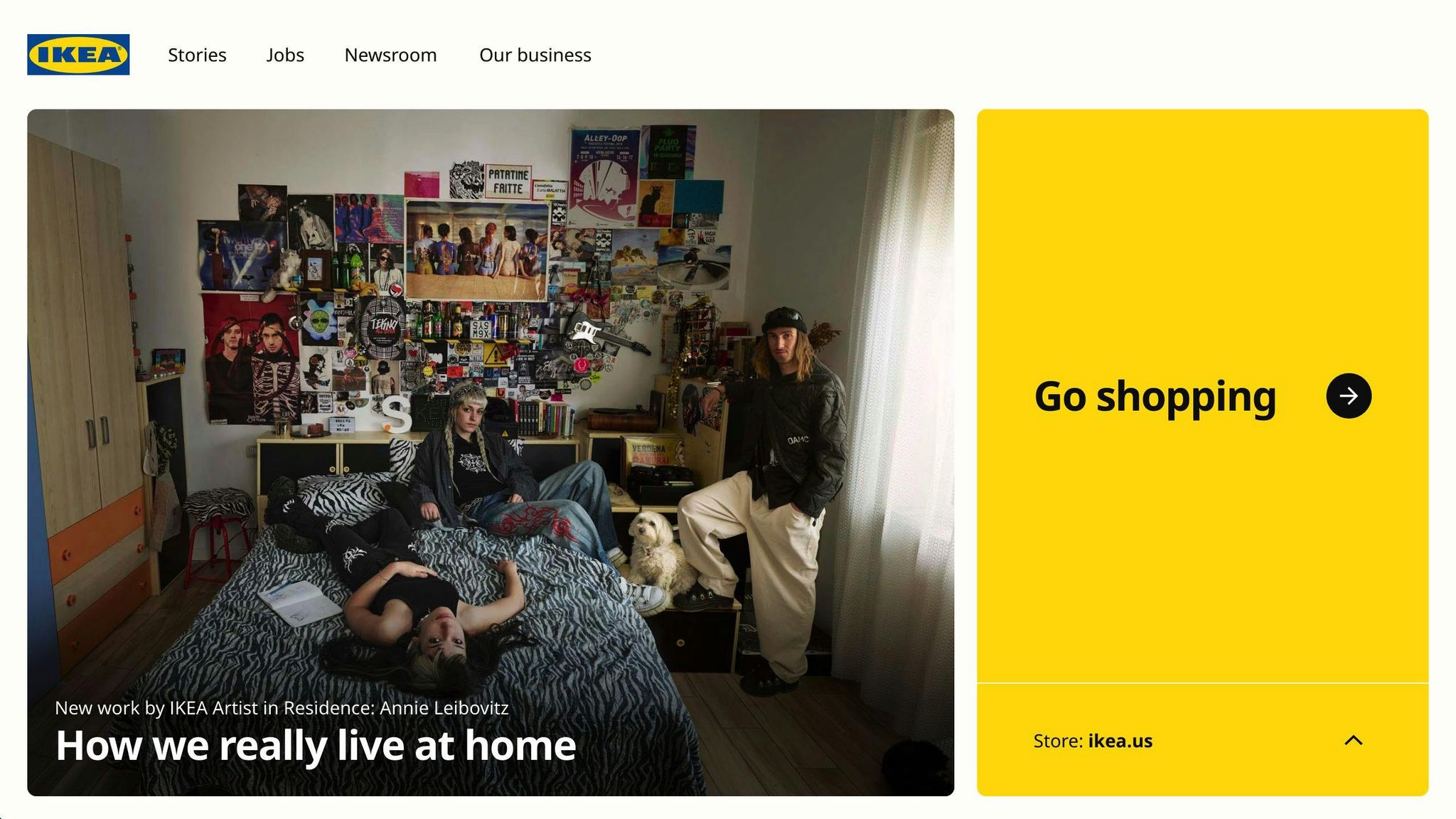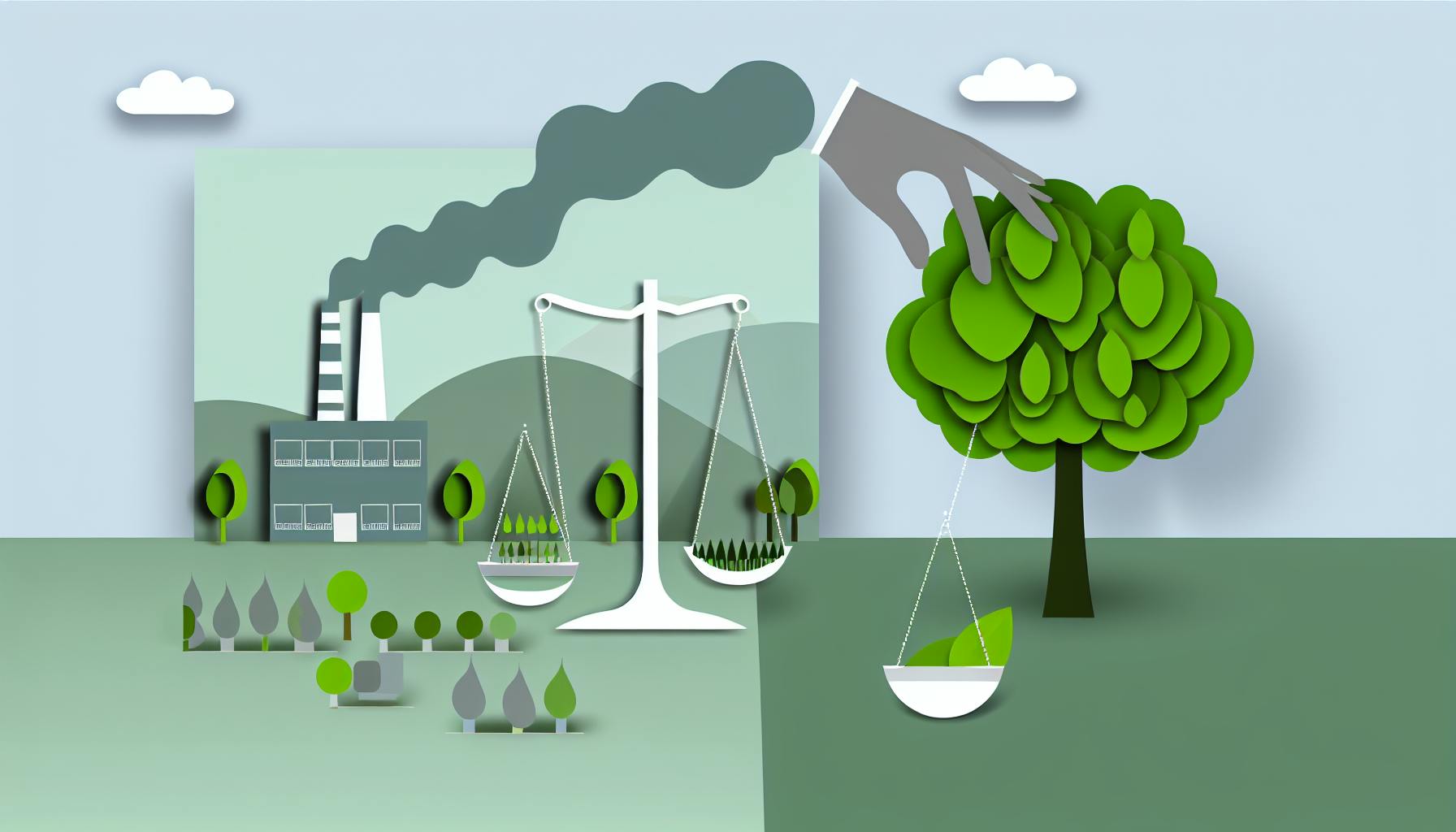Today, being environmentally responsible is not just a choice but a necessity for companies worldwide. This guide highlights companies leading the way in sustainability, their innovative strategies, and the importance of supporting green businesses. Here's a quick overview:
- Environmentally Responsible Companies: These are businesses that integrate eco-friendly practices across their operations, from sourcing materials to waste management.
- Strategies for Sustainability: Includes using renewable energy, reducing waste, ethical sourcing, and transparent reporting.
- Leading Examples: Patagonia, IKEA, and Seventh Generation stand out for their commitment to the environment.
- Supporting Sustainable Companies: Doing so benefits the environment, society, and the economy.
- Challenges and Future Trends: While there are obstacles, the future points towards stricter regulations, mandatory sustainability reporting, and a growing focus on ethical consumerism.
In simple terms, supporting companies that prioritise the planet is crucial for a sustainable future. Let's explore how businesses are making a difference and why it matters.
The Role of SaaS Tools for Emissions Tracking
Carbon Accounting Basics
Carbon accounting means figuring out how much pollution a company causes by doing its business. This includes pollution from:
- Direct emissions from things the company owns or controls (Scope 1)
- Indirect emissions from the energy the company buys, like electricity and heat (Scope 2)
- Other indirect emissions that happen because of the company's activities, but not directly from it (Scope 3)
Companies need to know exactly how much they pollute to see where they can cut down, share this info with others, and make better choices. But, getting all this data and doing the math can be tricky.
Key Features and Benefits
SaaS tools, such as EcoHedge, help companies keep track of their pollution in an easier way. Here's what they offer:
Custom analytics and reporting:
- You can look at emissions by different parts of the company, like departments or locations.
- Compare pollution to things like how much money you make or how much you produce.
- Create reports to understand and show how you're doing.
Data integration and management:
- Connect to different places where you get data, like energy bills or transport records, to gather all the info you need.
- Keep records straight for checking calculations.
- Make sure the data is good and fill in any missing pieces.
Stakeholder transparency:
- Share reports and info about your pollution openly.
- Make sure your reports match up with big environmental reporting standards.
- Use tools to tell your story about being more eco-friendly.
With these tools, companies can find out where they're causing the most pollution, set goals to pollute less, and tell everyone about the good things they're doing for the environment.
Case Study: EcoHedge
EcoHedge is a tool that helps companies understand and report their pollution. Here's how it helps:
Emissions Calculation Engine: It figures out how much pollution you cause, following the latest rules and guidelines.
Data Integrations: It can connect to places where you already have data, like your energy bills, to make gathering information easy.
Custom Analytics: It lets you see where your pollution is coming from and track it over time, by different parts of your company.
Reporting & Disclosure: It has a tool for making reports that fit with big environmental reporting standards, and you can even share your reports online.
Using EcoHedge, companies can really understand their pollution, find ways to reduce it, and share their journey towards being more environmentally friendly with everyone.
Criteria for Environmentally Responsible Companies
When we talk about companies that really care for the environment, they make sure this idea runs through everything they do. Here's what to look for to spot them:
Transparency and Reporting
- They tell everyone how they're doing with their environmental goals, using reports that follow certain standards.
- They set clear targets to cut down on pollution and show how they're doing.
- They're open about their environmental policies and how well they're sticking to them.
Ethical Sourcing and Supply Chain Management
- They make sure to get their materials in a way that doesn't hurt the planet and check that their suppliers do the same.
- They prefer suppliers who use solar energy and are working towards not polluting at all.
- They try to buy from local suppliers to cut down on pollution from transportation.
Energy Usage and Facilities
- They use energy from the sun, wind, or other renewable sources for all their operations.
- Their buildings meet green standards, showing they're built in an eco-friendly way.
- They make their buildings more energy-efficient and use smart tech to help.
Waste and Water Reduction
- They aim to not waste anything and focus on reducing, reusing, and recycling.
- They use packaging that's better for the environment and plan their shipping to avoid waste.
- They use water wisely and recycle it.
Offset Programs
- They support projects that help make up for the pollution they can't avoid, like planting trees or investing in renewable energy.
- They choose projects that help with renewable energy, planting trees, or protecting animals and plants.
Product Innovation
- They think about how making, using, and throwing away their products affects the environment and try to make this better.
- They use recycled materials in their products and look for ways to reuse what they make.
- They offer services to fix products or take them back when you're done with them.
Culture and Leadership
- The people in charge show they're serious by setting up special roles and goals for being more eco-friendly.
- They make sure their workers know how to be kind to the environment.
The best companies make protecting the environment a key part of who they are. Getting a stamp of approval from groups like B Corp shows they're really committed.
Implementing Corporate Sustainability Strategies
Companies today are feeling the pressure from everyone involved - from their workers to their customers - to really focus on sustainability. This means they need to figure out how to lessen their impact on the environment, make sure their supply chains are sustainable, and get both employees and customers excited about being green. Here's a simple breakdown of how to do it:
Measuring Environmental Impact
- First, figure out how much pollution your company is responsible for. This helps you know where you stand and find the biggest areas you can improve.
- Make goals based on science to cut down your pollution. These goals should be in line with global efforts to fight climate change, like the Paris Agreement.
- Use tools (like EcoHedge) to keep track of how much pollution you're creating and see if you're meeting your goals.
- Look at your pollution data to find out where you can make the biggest cuts.
Building Sustainable Supply Chains
- Ask your suppliers about their environmental efforts and make sure they meet certain standards.
- Have rules that suppliers need to follow to work with you.
- Check on your suppliers to make sure they're actually doing what they say they are. Help them get better if they're not.
- Reward suppliers who do well in being green.
- Keep an eye on your suppliers' green efforts in real-time by using special software.
Engaging Employees and Customers
- Teach your employees about why being green is important and what your company is doing about it.
- Get employees involved in green projects or challenges and reward them for participating.
- Tell everyone how you're doing with your green goals on your website, social media, and in reports.
- Ask your customers what they think about your green products and practices and listen to their feedback.
- Show customers the good they're doing by choosing your eco-friendly products through online dashboards.
By focusing on these areas, you can really make a difference in reducing pollution and making your business more sustainable. The key is to set big goals, keep track of your progress, and get everyone involved.
Spotlight: Leaders in Environmental Responsibility
Patagonia

Patagonia is known for really caring about the environment and doing business in a way that helps the planet. Here's what they do:
Materials Innovation
- They create new eco-friendly materials, like turning trash into fabric and making wetsuits from plants.
- Their products are made to be reused, recycled, or to come from renewable sources.
- They invest in businesses that turn waste into something useful.
Ethical Sourcing & Supply Chain Transparency
- They know exactly where their materials come from, sometimes even down to the farm.
- They check that the places making their products treat workers well and protect the environment.
- They make sure the people making their products get paid enough to live on.
Activism & Advocacy
- They've given more than $100 million to groups that protect nature.
- They help people get involved in important issues through their Action Works platform.
- They close their stores on Election Day so employees can volunteer.
Patagonia is always finding new ways to be better for the environment, setting an example for others.
IKEA

IKEA is a big company that's working hard to be more eco-friendly. They're doing things like:
Renewable Energy
- They plan to make more clean energy than they use by 2030.
- They've put over 1 million solar panels on their buildings.
- They own wind turbines and solar farms to make clean energy.
Responsible Sourcing
- They make sure the materials they use, like cotton and wood, come from places that don't harm the environment.
- They check that their suppliers treat workers right and are good to the planet.
- They want all their wood to be recycled or certified as eco-friendly by 2025.
Circular Product Design
- They're trying out ways for people to sell back used furniture.
- They're testing renting, fixing, and recycling furniture.
- They design products so they can be taken apart and recycled.
IKEA wants to have a positive impact on the climate and show big companies how to reduce their harm to the planet.
Seventh Generation

Seventh Generation focuses on making products that are good for the planet and future generations by:
Plant-Based Ingredients
- They use plants to make cleaning, personal care, and baby products.
- They never test on animals or use animal parts in their products.
- They aim for their products to be made mostly from plants.
Sustainable Packaging
- All their packaging can be recycled, and most of it already is.
- They use recycled materials and safe inks for their packaging.
- They try to use less packaging to reduce waste.
Zero Waste Operations
- They keep most of their waste out of landfills.
- They turn waste they can't recycle into compost.
- They make up for the pollution from traveling for work.
Seventh Generation works hard to make sure their products and how they do business are as green as possible.
sbb-itb-0f1f828
The Importance of Supporting Sustainable Companies
Supporting companies that care about the environment is good for the Earth and everyone living on it. Here's why it matters:
Environmental Benefits
- Helps fight climate change by reducing harmful gases
- Keeps natural places like forests and rivers healthy
- Encourages new eco-friendly products and ways of doing things
When people buy from green companies and businesses work with eco-friendly suppliers, more companies start to think about the environment. This can lead to big changes, like less pollution and better care for nature.
Social Benefits
- Makes sure workers are treated fairly and safely
- Encourages companies to be open about what they're doing
- Helps create a work environment where caring for the planet is important
Companies focused on being green also make sure they treat people right and are honest about their actions. This good behavior becomes a part of the company's culture, making employees more involved in green projects.
Economic Benefits
- Leads to new inventions and business ideas
- Saves money by using resources wisely
- Draws in investors and skilled workers
Moving towards being more sustainable opens up new opportunities for cleaner technology and business methods. It also means companies can save money in the long run and attract people who want to invest or work for them because they're seen as responsible.
Key Takeaways
- Supporting green businesses helps our environment, society, and economy
- It encourages more companies to adopt sustainable practices
- Making choices that support the environment can lead to big changes for a better future
By choosing to support companies that are doing the right thing for the planet, we all can play a part in making a positive difference.
Overcoming Challenges in Corporate Sustainability
Becoming more sustainable isn't always easy for companies. It can cost a lot of money upfront and require big changes in how things are done. However, with some smart planning, these obstacles can be tackled.
Managing Upfront Costs
Projects like installing solar energy systems or switching to electric vehicles can be expensive at first. Here are some ways to handle this:
- Look for government grants and incentives for eco-friendly projects
- Use tools like EcoHedge to figure out when you'll start seeing a return on your investment
- Begin with projects that will save money quickly before taking on bigger investments
- Consider loans from companies that support green projects
Bridging Data and Technology Gaps
Sometimes, companies don't have the right information, tools, or knowledge to get better at being green. Here's how to fix that:
- Use software like EcoHedge to keep track of and report on emissions data
- Bring in experts like sustainability managers and data analysts
- Teach employees about the best ways to be eco-friendly
- Make gathering data easier by automating it, like using sensors or software to track energy use
Aligning Suppliers and Partners
It can be challenging to get your suppliers and partners to follow your green standards. Some strategies include:
- Be clear about your environmental expectations with suppliers
- Include green goals in your contracts
- Give bonuses to partners who do really well in meeting these goals
- Share knowledge and tools to help suppliers get better
- Work closely with suppliers who share your commitment to being eco-friendly
With careful planning for costs, smart use of technology, and working together with suppliers, companies can overcome the hurdles to becoming more sustainable.
The Future of Environmental Responsibility
As our planet feels the heat of climate change and more people start worrying about it, businesses will have to step up and take care of their impact on the environment. Here's what's coming up in the world of being good to our planet:
Stricter Regulations
Countries all over are setting tougher rules about pollution, waste, using water, and other important stuff. Businesses will have to keep a close eye on how they're doing environmentally and show they're following the rules. If they don't, they might have to pay big fines or even lose their permission to operate. Staying on top of new rules will be super important.
Mandatory Sustainability Reporting
More places are making it a must for companies to tell everyone how they're doing with being green, like how much pollution they're cutting down. Everyone will start using the same way of reporting this info. Companies that don't have good data or plans for being more sustainable might find it hard to attract money and the best people to work for them.
Supply Chain Accountability
Businesses will be held responsible for making sure the entire chain of companies that supply them are also being green. This means making sure all suppliers are up to scratch with how they get materials, make things, and move them around without harming the planet. Companies that can't show this might lose their good reputation.
Growth Of Sustainable Investment
More money is going towards companies that are good for the planet, while those that aren't might lose investments. Tools like EcoHedge will be really important for investors who want to pick companies based on environmental, social, and governance (ESG) factors. Showing you're leading in sustainability will be key to getting investment for growth.
Mainstream Ethical Consumerism
People everywhere are picking brands that match their care for the environment. With tools like EcoHedge Engage, companies can show off what they're doing to be green to their customers. As more people care, being open and honest about your green efforts will be crucial to win over customers.
While moving towards sustainability might have its tough spots, companies that start taking responsibility now will benefit in the long run. The future is for brands that are truly committed to protecting our planet.
Conclusion and Key Takeaways
We've learned that if companies want to do well and keep up with new rules and what people expect, they need to put caring for the environment at the heart of their business. Here are the main points:
Use Tools to Track and Cut Emissions
- Find out how much pollution your company causes from all sources to see where you can do better.
- Make goals based on science to pollute less, in a way that helps fight climate change.
- Use online tools like EcoHedge to make keeping track of pollution easier and to report on it simply.
Build Truly Sustainable Supply Chains
- Make sure you have clear rules for picking materials and suppliers that are good for the planet.
- Regularly check if your suppliers are sticking to the rules by auditing them and using up-to-date data.
- Work together with your partners to achieve common green goals.
Get Employees and Customers On Board
- Create a work environment where everyone cares about the environment through training and involvement.
- Be open about what you're doing to be more sustainable and share your successes.
- Get customers and employees involved in your green efforts to encourage more action.
Overcome Hurdles With Proper Planning
- Look for government perks for green projects and use data to justify spending on these projects.
- Bring in experts and technology to fill in any gaps in what you know or can do.
- Join forces with your suppliers to overcome any challenges in meeting green standards.
Prepare Now for the Future
- Keep up with changing rules and the need to report on sustainability by staying proactive.
- Use tools like EcoHedge to show off your green progress to attract investors and talented workers.
- Respond to the increasing demand for ethical brands by being transparent.
By starting to integrate caring for the environment and sustainability into their business now, companies can be ready for the future. This not only helps with climate change but also gives companies a chance to lead by example.
Related Questions
What is an environmentally responsible company?
An environmentally responsible company is one that really tries to lessen its impact on our planet. This means they do things like:
- Keep track of how much pollution they cause and work to reduce it.
- Use energy from the sun or wind instead of burning fossil fuels.
- Choose materials and processes that are less harmful to the environment.
- Recycle and reuse things instead of throwing them away.
- Support projects that help the environment, like planting trees.
- Share openly about their efforts and progress in being more eco-friendly.
These companies not only help the planet but also often save money and attract customers who care about the environment.
What company is the most environmentally friendly?
Some top eco-friendly companies include:
- Patagonia - They make outdoor gear with sustainable materials and support environmental causes.
- Ørsted - A leader in wind energy, almost all of their energy comes from renewable sources.
- IKEA - This furniture store uses sustainable materials and aims to recycle and reuse.
- Seventh Generation - They make cleaning products from plants and use recycled packaging.
- Beyond Meat - Their plant-based meats are more eco-friendly than traditional meats.
What are big companies doing to help the environment?
Big companies are taking steps like:
- Switching to Renewable Energy: Companies like Google and Amazon are using wind and solar power.
- Stopping Deforestation: Brands like Nestlé are making sure the products they sell don't harm forests.
- Recycling and Reusing: Companies like IKEA and H&M are finding ways to use things again instead of throwing them away.
- Investing in Carbon Removal: Microsoft and others are putting money into new ways to take carbon out of the air.
Is IKEA a green company?
Yes, IKEA is working hard to be more environmentally friendly. They're investing in renewable energy, aiming to use only recycled materials, and trying to reduce their carbon footprint. They're open about their goals and progress, but they still have more work to do to be completely eco-friendly.



